Phosgene poisoning is considered a very dangerous condition that threatens both health and human life. The effect of a volatile compound on the respiratory system provokes the appearance intoxication and asphyxiation. Failure to provide medical assistance in a timely manner can lead to death.
Record content:
- 1 What is gas
- 2 Action on humans
- 3 Signs of poisoning
- 4 Intoxication pathways
- 5 First aid for poisoning
- 6 Poisoning treatment
- 7 Phosgene antidote
- 8 Health consequences
- 9 Phosgene video
What is gas
Phosgene is a colorless gas that, at temperatures below 8.2 ° C, can turn into a fuming liquid. It is described by the following formula: COCI2.
The characteristics inherent in this gas are listed in the following list:
- actively reacts to alkali, ammonia, aluminum, copper;
- in case of heating, it can decompose into corrosive and toxic fumes;
- reacts with water, alcohols and moisture;
- not fire hazardous;
- upon contact with water, a slow process of hydrolysis begins with the release of hydrochloric acid;
- at very low concentrations, this gas smells like freshly cut hay, and at high concentrations it can become pungent and suffocating;
- together with water, it is capable of destroying metals, rubber and plastic;
- can dissolve in most known liquid hydrocarbons.
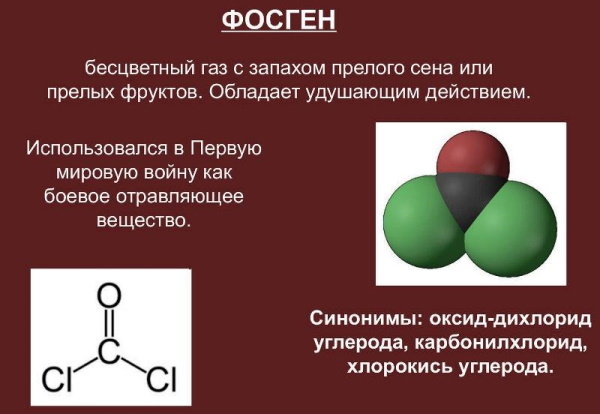
Phosgene is transported in liquid form and large volumes are stored in a dry, fireproof, cool and well-ventilated place.
Gas is mainly used in industrial production, since it is a very valuable reagent, a synthesis element organic compounds and combustion product of household components, which contain organochlorine volatiles connections.
At home, fire victims experience poisoning associated with the release of phosgene during the combustion of compounds in refrigeration units. It can also be obtained by welding metal structures purified with chlorinated hydrocarbons.
Since the gas is toxic and dangerous, it is often produced and consumed within the same facility, which takes special precautions related to its storage.

It is on list 3 of the Chemical Weapons Convention, and industrial sites manufacturing more than 30 tons per year of this chemical compound, constantly checked by the Organization for the Prohibition of Chemical weapons. Sodium bicarbonate is used to neutralize liquid gas spills, and gaseous-type leaks are softened with ammonia.
Action on humans
Phosgene (the effect on humans is poisonous) belongs to the section of lung poisons, as well as the following list of chemical compounds:
- ammonia;
- beryllium and its derivatives;
- gases of the nitrous type;
- diphosgene (the result of the production of phosgene);
- iodine;
- sulphur dioxide;
- hydrogen sulfide;
- chlorine and components with its content.
Phosgene poses a particular danger to human life due to carbonyl chloride poisoning. Phosgene has an effect on the body, which consists in damage to the respiratory tract, irritation of their mucous membranes, burns and pulmonary edema when inhaling a poisonous substance.

In the body, you can observe the following changes:
- hypoxia and acidosis increases lung flow, which affects blood flow to the alveoli;
- the psyche is disturbed;
- some parts of the body and skin may be prone to frostbite;
- phosgene vapors can irritate the lung and bronchial structures;
- the membranes of the lungs are destroyed;
- too high a concentration of phosgene will have a negative effect on the cornea of the eye.
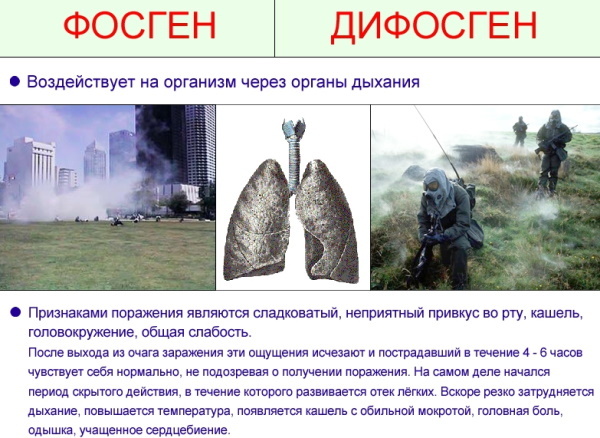
Phosgene is dangerous in that it can strike with a suffocating property for 3 to 15 hours without the characteristic symptoms.
Signs of poisoning
Phosgene (effects on humans and the severity of poisoning directly depend on immunity and gas concentration) acts in such a way that in case of poisoning pulmonary insufficiency begins to develop, which contributes to an inadequate supply of oxygen to the body, blood clots begin to form, which clog veins.
The period of manifestation of the first symptoms of intoxication directly depends on the characteristics of the victim's body, as well as on the continuation of contact with them and the concentration of the poisonous substance itself.
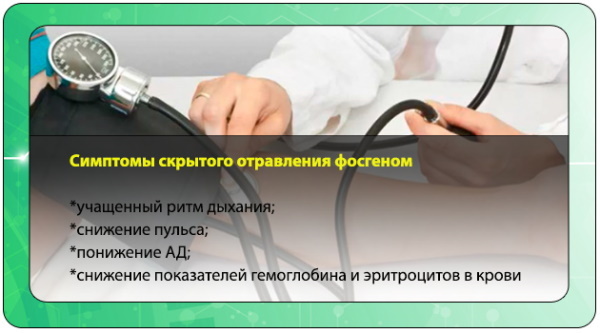
The following table shows the concentration of a toxic chemical:
| Gas concentration in air | Inhalation duration | Detection of symptoms of intoxication and their consequences |
| Up to 0.004 mg / l | From 1 hour to 1 hour 30 minutes. | Signs in this case may not always appear. |
| 0.004-0.01 mg / l | Not more than 1 hour | Poisoning can manifest itself in a very mild form, but most often there are no signs. |
| 0.01-0.022 mg / l | More than 30 min. | There is a high probability of death. |
| Above 0.1 mg / l | Within 30 to 60 minutes. | Half of the victims have a lethal outcome, and the survivors have complex consequences up to the onset of disability. |
| Presence of 1 mg / l phosgene in the air | This concentration is lethal if it comes into contact with gas for more than 5 minutes. | The victim is fatal almost instantly, within 1 to 3 seconds. |
At low concentration, the following unpleasant sensations can be observed:
- inflammation of the cornea of the eye;
- headache and dizziness;
- cough and watery eyes;
- nausea and shortness of breath.
Too much concentration can burn the lung tissue and cause the airways to contract, which can lead to respiratory arrest.
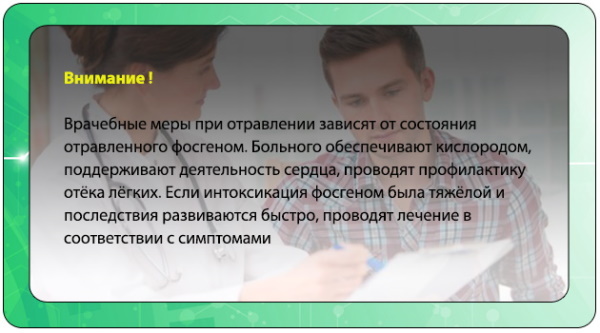
Classic severe phosgene poisoning consists of 4 stages, which are described in the following paragraphs:
- Influence stage. The gas affects the mucous membranes and human skin. The higher the concentration, the more pronounced redness of the eyes and irritation of the respiratory tract. Also, discomfort occurs in the chest area, nasopharynx, salivation, coughing appears, and breathing becomes difficult.
- Hidden period. The phase that combines the end of exposure to the toxin and the appearance of signs of poisoning. With the improvement of well-being and the extinction of symptoms, the effect of the poison still continues. The latent stage in gas poisoning can last from 1 to 24 hours, and the average value ranges from 4 to 6 hours. The shorter the period of imaginary normalization of well-being, the more dangerous the situation becomes.
- Stage of toxic pulmonary edema. A person begins to experience a headache, heaviness in the chest area, shortness of breath, cough, and the feeling of weakness does not leave for a minute. The tips of the lips, nail phalanges and nose begin to turn blue. After the chest pain begins to intensify, the general condition worsens, and the body temperature can reach 39.5 ° C. Then there is a cough with increased production of sputum with foam and shortness of breath up to 60 breaths per minute. By the end of the first day, toxic pulmonary edema can reach its maximum, the skin and mucous membranes gray, cold and clammy sweat is released, breathing becomes irregular, and the pressure drops below 70 mm Hg pillar. The result is death due to the fact that the respiratory and cardiovascular systems can not cope with the load.
- Period of edema resolution. In the absence of death, the edema may subside within 4 days, and full recovery should be expected after 3 weeks. When a secondary infection is attached, pneumonia can develop with a possible fatal outcome.
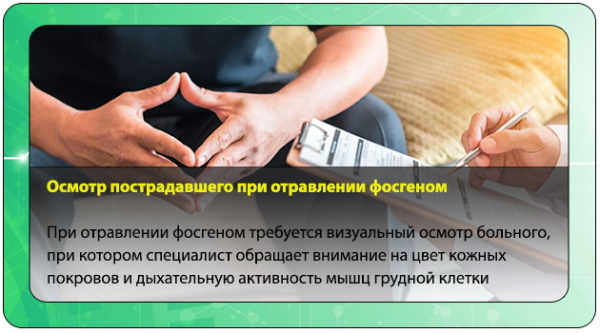
An important point is a visit to a doctor in case of suspicion of poisoning, since in the latent stage the symptoms go away, but after the person's condition can worsen greatly.
Intoxication pathways
Phosgene (the effect on a person in the affected area, in high concentration, has severe poisoning) after ingestion, it begins to cause pulmonary edema slowly type. It is not retained in the lungs, since it is insoluble in the aquatic environment.

The following factors of intoxication are distinguished:
- accident of a transport used to move phosgene;
- industrial emergencies;
- fighting, in which phosgene is chosen as the main lethal weapon.
The defeat occurs due to a direct effect on the lung tissue by binding to biological membranes. The result is their death. Also, over time, lung cells die, the volume of the substance, which does not allow the alveoli to stick together, decreases, and the person begins to experience oxygen starvation.

When phosgene gets on the skin, erythema and irritation occur, and if the gas concentration in the air is too high, visual function is impaired.
In direct contact with the liquid medium of the substance, it is possible to get frostbite and active irritation. The use of a chemical compound in industry requires increased care and attention. Children with gas poisoning develop symptoms much faster than adults.
First aid for poisoning
Exposure to the gas on the human body causes severe intoxication. In this regard, all employees of enterprises where phosgene or its derivatives are used must be instructed in the safety rules and principles of first aid in case of intoxication carbonyl chloride.
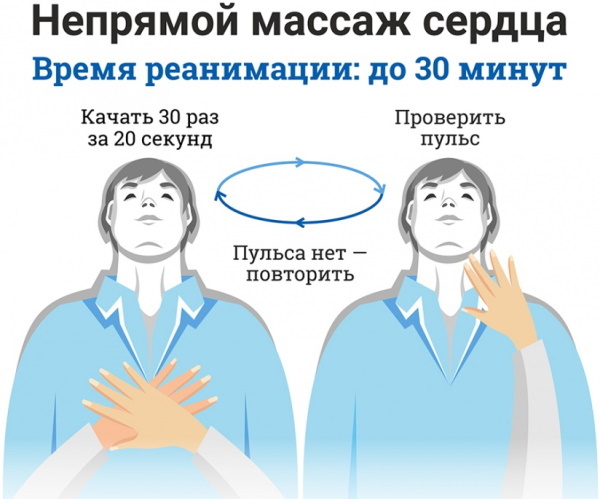
First aid is as follows:
- The victim must be urgently taken out into the open air from the zone of exposure to gas. It is required to put on a gas mask very quickly by calling an ambulance. The patient should adhere to maximum rest, since excess body movements can negatively affect his health.
- To reduce the amount of toxins entering the body, it is recommended to wash the patient's hair and skin with warm soapy water. It is advisable to rinse the eyes with saline.
- It is imperative to eliminate the cause of intoxication, in accordance with current rules at work. You will also need to organize the evacuation of the rest of the workers. Anyone who has been exposed to even the slightest influence of the poisonous gas must undergo a medical examination.
- If the patient does not have a heartbeat, he needs to perform an indirect heart massage. For this purpose, the victim should be laid on his back, on a hard surface. The palm is required to be placed on the lower half of the left chest, in parallel to put the second palm on top. In this case, the hands of the rescuer must always remain in a straightened position. Movements should be fast and rhythmic, about 120 times per minute.
- Before the arrival of the medical team, it is advisable to collect all information about the duration of the patient's interaction with gas vapors, as well as the characteristics of the chemical compound. Clothes that have been contaminated with a toxic substance must be disposed of by incineration.
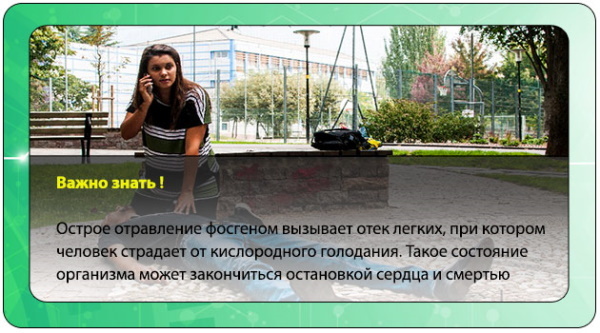
If after the latency period there are no symptoms of intoxication, you should not neglect the help of doctors. The victim is obliged to undergo an examination within 14 days in order to identify complications in a timely manner.
Poisoning treatment
Phosgene (exposure of a person to a poisonous gas can cause serious consequences) during the latency period may not give symptoms of intoxication. After providing first aid, the patient must be taken to the toxicology department.
To analyze the condition of the victim, the following data are used:
- to determine traces of single erythrocytes and protein, urine analysis is required;
- to determine the reduced volume of hemoglobin and erythrocytes, a detailed blood test is required;
- the smell of clothing, skin and hair of the patient;
- palpation of the lymph nodes;
- blood pressure indicator;
- chest x-ray;
- respiratory rate (in a healthy person 20 times per minute);
- heart rate.
Therapeutic treatment must necessarily be carried out in a stationary environment. The victim should wash the stomach with a solution of copper sulfate or 0.04% manganese solution.
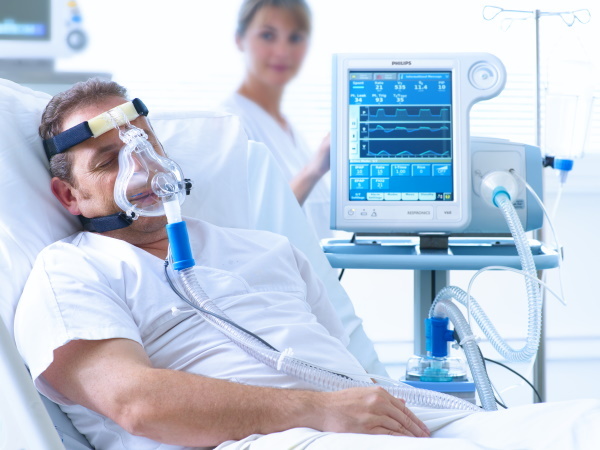
After the following procedures are performed:
- artificial ventilation of the lungs;
- bowel cleansing with the use of saline laxatives (magnesia);
- the use of an anti-smoke mixture, which contains ethyl and ammonia, ether and chloroform.
When drawing up a treatment course, antihistamines are additionally used, compounds for normalizing cardiac activity, blood flow and eliminating toxic substances.
Phosgene antidote
To date, no phosgene antidote has been developed. In the form of an antidote, a weak solution of copper sulfate is mainly used. However, in official medicine, it is not considered an antidote, but it can neutralize the effects of a toxic chemical compound.
At 1% concentration, copper sulfate is injected into the body by injection. The dosage is prescribed by a specialist on an individual basis.
Health consequences
If phosgene has become the cause of body poisoning, the following concomitant pathological conditions may occur:
- venous thrombosis of the extremities;
- pleurisy;
- bacterial pneumonia;
- pneumosclerosis;
- renal and hepatic dysfunction;
- expansion of the myocardium;
- emphysema of the lungs.
If there is no adequate treatment of the above diseases, irreversible consequences may occur. To stop the development of diseases, it is required to adhere to all medical recommendations at the stage of treatment of intoxication.

At the stage of the recovery period, it is necessary for 14 days after complete recovery to be constantly examined by the attending doctor. At this stage, the patient takes a series of tests that will help determine the presence of toxic substances in the body.
Preventive measures for gas poisoning are as follows:
- the use of protective equipment in the form of respirators, special shoes and clothing, as well as rubber gloves;
- compliance with all safety regulations;
- compliance with the instructions for storing phosgene;
- observance of caution in the process of transporting a poisonous substance.
If you find minor toxic symptoms, you must immediately consult a doctor. Provided timely medical care is able to eliminate irreversible consequences that can cause death.
Phosgene poisoning poses a threat not only to health, but also to human life. Therefore, it is very important to provide first aid in a timely manner, otherwise exposure to the gas can be fatal. This is due to the fact that a volatile compound, entering the respiratory system, provokes the development of intoxication and asphyxia.
Phosgene video
Interesting Odor and Gas Facts:



